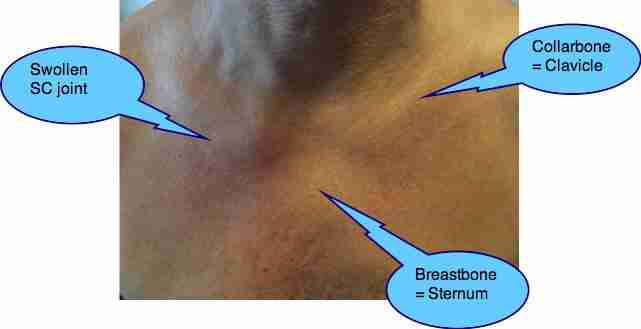I have a small soft lump on my left side below my collarbone and it doesn't hurt what could it be? Michael Sparacino answered 37 years experience Family Medicine See below: Any lumps should be examined by your family doctor to make sure they're not dangerous. Lump On Collar Bone In Front Neck; Soft Painless Lump On Collarbone Back; Whatever be the reason, if the fractured pieces are not aligned properly, a lump may result at the fracture site. Lipoma: It is another common reason of a lump on the clavicle. This lump is soft in nature and is a result of deposition of fat tissue at any point on the. I developed a soft squishy lump about 1-2 inches overnight above my collarbone on the front right. This is Friday i noticed it Wednesday night.It doens t hurt at all. This is Friday i noticed it Wednesday night.It doens t hurt at all. “Lymphomas may present as painless swelling in the lymph nodes of the neck and collarbone region, or the armpits or groin,” continues Dr. Abnormal Lump on the Collarbone (Clavicle) that Was Never There Before “The clavicle is a very superficial bone,” says Dr. Nov 26, 2018 I'm a 27yo female and about 3 weeks ago I found a lump above my left collarbone. It's about the size of a tic tac, it's movable And I think quite soft? Even though the more i touch it the harder it seems! I went to the doctors and she didn't seem too concerned as I've had no other symptoms.
- Lump On Collarbone Doctor
- Calcium Deposit On Collarbone
- Soft Painless Lump On Collarbone Near
- What Is A Lump On My Collarbone
- Soft Painless Lump On Collarbone Bone
- What Causes A Lump On Your Collarbone
- Lump On Left Collarbone
Overview
What is a ganglion cyst?
A ganglion cyst (plural: ganglia) is a small, fluid-filled lump just below the skin. Ganglia usually form close to a joint. Most ganglion cysts are on the wrist, finger or foot.
Lump On Collarbone Doctor
How common are ganglion cysts?
Lots of people get ganglion cysts. Ganglia are some of the most common benign (noncancerous) masses that develop in the body’s soft tissues.
Symptoms and Causes
What causes ganglion cysts?
No one knows exactly what causes a ganglion cyst to start growing. Some theories indicate that a cyst may develop after something injures a joint, allowing tissue to leak or bulge out.
Currently, most researchers agree that ganglion cysts develop from mesenchymal cells at the synovial capsular junction as a result of the continuous micro-injury. Repetitive injury to the supporting capsular and ligamentous structures appears to stimulate fibroblasts to produce hyaluronic acid, which accumulates to produce the mucin 'jelly-like' material commonly found in ganglion cysts
Who gets ganglion cysts?
From what the medical community understands about ganglion cysts, anyone can get them. Certain factors may increase your chances of having one of these cysts:
- Sex: Women develop ganglia three times more often than men.
- Age: For most people who develop a ganglion cyst, it appears in early to mid-adulthood, between 20 and 50.
- Previous injury: Some healthcare providers believe a joint injury (such as tendonitis from overusing your wrist) could spur a ganglion cyst to develop in the future. Research hasn’t proven this theory yet.
- Arthritis: Having arthritis in your hands makes it more likely you’ll get a ganglion cyst. People with arthritis often get a ganglion cyst near their fingertips (at the joint closest to the nail). But having a ganglion cyst on your finger does not mean you have (or will get) arthritis.
What are the symptoms of ganglion cysts?
A bump beneath the skin is the main sign of a ganglion cyst. This bump can vary in size and shape. It may grow larger over time or when you use that area (joint) more. The cyst may not bother you at all. If you do have symptoms, you may notice some muscle pain or a tingling sensation. This is usually mass effect, which means that the mass is causing pressure and may cause inflammation.

Where do ganglion cysts appear?
Ganglion cysts usually appear at specific joints. Using the joint near the cyst may increase swelling and worsen any discomfort you feel.
Ganglion cysts typically develop on the:
- Wrist: On the front or back.
- Finger: Near any finger joint (close to your palm or just below the fingernail).
- Foot: Close to your ankle or near your toes.
What does a ganglion cyst look like?
A ganglion cyst usually looks like a lump or bump on your wrist, finger or foot. This lump may look symmetrical (round) or misshapen (more like an oval).
A ganglion cyst sits just below the skin’s surface. It may look like a bubble blown from a joint. Ganglia sometimes have a translucent effect (you can see through the lump at certain angles).
Are ganglion cysts hard or soft?
People experience ganglion cysts differently. Ganglia are usually (but not always) firm to the touch. Some people report that the fluid-filled cysts as soft. The lump likely moves easily under your skin.
Diagnosis and Tests
How is a ganglion cyst diagnosed?
Healthcare providers usually diagnose ganglia by physically examining you. A lump’s appearance and location (such as on the wrist or fingers) are telltale signs of ganglia. Your provider may press on the bump to see if it bothers you. Or they may shine a light on the lump to see if it’s translucent (partly see-through).
In some cases, your provider may remove a sample from inside the lump (called a biopsy) for further analysis. Ganglia usually contain a jellylike fluid, not solid tissue. In rare cases, your provider may recommend an X-ray to learn more about what’s causing your symptoms.

Your provider may use ultrasound to tell the difference between a solid mass and a cyst. There is also a difference between a ganglion cyst and a synovial cell. The difference is in the make-up of the lining of the cyst.
Can you have problems from a hidden ganglion cyst?

Some ganglion cysts are so small that they don’t cause obvious physical swelling, but they still cause pain. They are known as occult ganglions. Your healthcare provider may order a magnetic resonance imaging (MRI) test or an ultrasound to reveal them.
Management and Treatment
Calcium Deposit On Collarbone
Do all ganglion cysts need to be treated?
If a ganglion cyst doesn’t bother you, it might not need treatment. Sometimes a ganglion cyst goes away on its own.
Your provider may recommend treatment if a ganglion cyst:
- Hurts, which may happen when a cyst presses against a nerve or joint tissues.
- Makes certain movements or tasks difficult, such as walking or gripping a pencil.
- Makes you self-conscious about your appearance.
Soft Painless Lump On Collarbone Near
How are ganglion cysts treated?
Ganglia cyst treatments include:
- Anti-inflammatory medication may minimize swelling, easing mild levels of discomfort.
- Splints or braces offer support and stop you from moving the affected area, reducing swelling and pain.
- Aspiration is a procedure where your provider uses a needle to remove fluid from the cyst. Providers usually do aspiration in their office. You may feel better right away. Because this treatment only removes the fluid and not the entire cyst, your symptoms may return.
When does a ganglion cyst need surgery?
Your provider may consider surgery if other treatments don’t provide relief or your cyst comes back. Surgeons treat ganglia by removing the entire cyst. A cyst often includes a stalklike structure (root) attached to the cyst.
Your surgeon may use open (traditional) techniques or arthroscopy (tiny incisions). In some cases, surgeons may take some tissue from the nearby joint to fully repair the problem.
Surgery to remove a ganglion cyst is called ganglionectomy. It is usually an outpatient procedure. That means you should get to go home the day of surgery. Full recovery takes two to six weeks. [SD1] Orthopedic surgeons receive specialized training to perform intricate procedures on the body’s joints and other soft tissues.
Surgery may effectively resolve your symptoms. Having a ganglion cyst surgically removed greatly reduces the risk of a cyst coming back. Still, ganglia come back after surgery in an estimated 5% to 15% of cases.
Prevention
Can ganglion cysts be prevented?
You can’t prevent a ganglion cyst. Medical experts don’t know what causes them to develop.
What Is A Lump On My Collarbone
Outlook / Prognosis
Are ganglion cysts dangerous?
Ganglion cysts are not dangerous. They are benign masses, which means they will not spread to other areas. Ganglion cysts are not cancer.
What is the prognosis (outlook) for people with ganglion cysts?
While some ganglion cysts may be painful, they pose no serious threat to your health.
Living With
What questions should I ask my healthcare provider?
If you have a ganglion cyst, you may want to ask your healthcare provider:
Soft Painless Lump On Collarbone Bone
- Do I need treatment right now?
- Which treatment options do you recommend I try first, and why?
- What are the chances a cyst will come back after treatment?
- When would you consider surgery to treat ganglion cysts?
- What are the risks and benefits of ganglionectomy surgery?
A note from Cleveland Clinic
What Causes A Lump On Your Collarbone

Lump On Left Collarbone
If you have a ganglion cyst, you may not need treatment right away. If the lump doesn’t bother you, your provider may follow you over time to check for any concerning changes. Ganglion cysts are benign, which means these lumps aren’t cancer. They pose no long-term threat to your health. Many ganglion cysts go away on their own. If a ganglion cyst affects your quality of life in any way, ask your provider about treatment options. Splints, over-the-counter pain medication or surgery may provide relief.